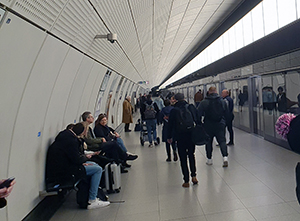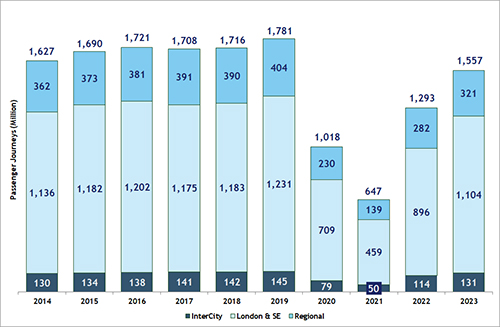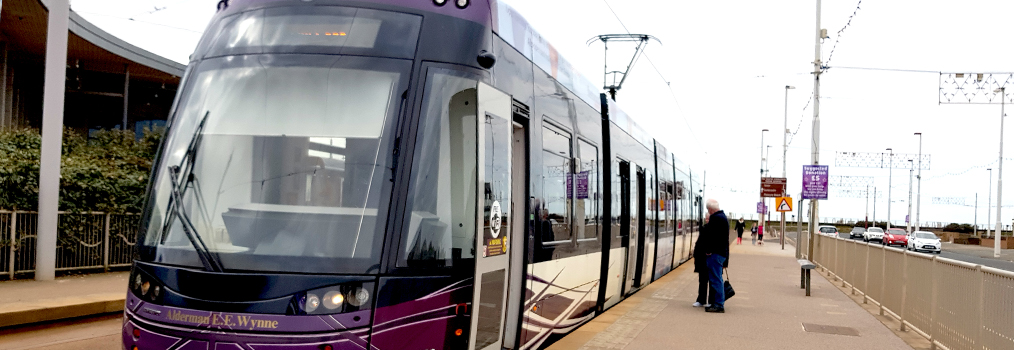Busy autumn quarter helps demand recovery
40% Elizabeth Line growth helps lift demand above 90% of pre-Covid levels
The recovery in demand for rail services in Britain from the Covid pandemic continued into the autumn of last year, with the pace of growth accelerating a little. Non Elizabeth Line passenger numbers were 17.1% higher than the same quarter in 2022, reaching a new post lockdown high. Including traffic on the new line, growth was 19.9%.
Overall, demand came to within 90.9% of pre-Covid levels, according to National Rail Trends statistics, published by the Office of Rail and Road (ORR). However, without the Elizabeth Line, the recovery is to 80.7%.
The provisional figures cover the third quarter of fiscal year 2023/24, finishing at the end of December: across the network, 417.4m passenger journeys were made during the twelve-week period, up from 348.1m in 2022. Between them, they covered 15.2 billion passenger kilometres, 15.7% up, and paid a total of £2,616.6m in fares, 24.7% more than in 2022.
Looking at demand by ticket type, advance tickets were up by 37.8%, taking sales 49% higher than before the pandemic. Anytime peak and off-peak fares were up by 18.7% and 21.0% respectively, leaving them 10.7% and 18.9% ahead of the pre-Covid figure. Season ticket holders made 7.3% more journeys than last year, but the 56.3 million total remained 64% below the 2019 figure.
Excluding the Elizabeth Line, services in London and South East moved ahead by 14.9% during the quarter, but this meant that it was the slowest growing sector. Between them, the operators carried 234.2m passengers in 2023, but remaining 22.0% below 2019. Double digit growth was the norm for the sector, with strongest quarterly growth coming at London Overground (20.4%), followed by West Midlands (20.1%) and Greater Anglia (18.4%). The exception was c2c (6.1%).
The Elizabeth Line carried 58.5 million passengers in its sixth full quarter of operation, 40.3% up in the year. Figures for the line have been revised downwards following discovery of a tendency to overstate passenger numbers in the Lennon data. The revised figures show that the route accounted for 14.1% of the national network’s patronage in the October to December quarter, second only to GTR’s 17.1%.
Amongst the regional franchises, total patronage was 21.9% up on 2022 and remained 18.4% below 2019 levels. Amongst individual TOCs, Scotrail saw the strongest recovery, growing passenger numbers up by 33.9% during the quarter, though still 22% short of their 2019 figure. TransPennine, newly renationalised in the previous the quarter and delivering improved performance, was a close second in the growth stakes, seeing 33.3% more passenger journeys, recovering to 87.3% of the pre-Covid figure. TfW saw growth of 19% on the quarter and moved to within 17% of its 2019 figures. Merseyrail saw growth of 15.2% but demand remained almost 34% short of pre-Covid levels. Northern saw a rise of 14.3% in passenger journeys, leaving a shortfall of 23.6%.
The long-distance InterCity sector saw demand increase by 21.1% compared with 2022, leaving passenger numbers 6.7% short of 2019 levels. Avanti West Coast saw the largest growth, on 38%, coming therefore to 84.8% of pre-pandemic levels, followed by Cross Country on 26.3%, but still 16.5% down from 2019. EMR grew by 22.5%, taking passenger numbers 8.7% above pre-pandemic levels. Caledonian Sleeper saw growth of 20.4%, but still 13.0% short of previous highs. GWR advanced by 10.1% to 80.3% of pre-Covid patronage, though the shortfall will also include some transfer of Thames Valley suburban passengers to the Elizabeth Line since 2022. Though LNER saw the lowest growth at 6.4%, the operation is the second to exceed 2019 passenger numbers, 2.3% up.
Amongst the non-franchised operators, Hull Trains saw growth of 26.6% and exceeded their 2019 number by 29.5% whilst Grand Central grew numbers by 22.0% and moved 18.4% ahead of their pre-Covid patronage. Helped by the continuing recovery in air travel, Heathrow Express saw numbers grow by 4.8% in the quarter. This left patronage on the premium route still 21.6% short of previous peaks, suggesting the effect of competition from the Elizabeth Line with its superior links between the airport and central London. Lumo grew by 28.7% during the quarter.
Rolling year figures
The national totals for the twelve months ended 31 December show that, compared with the last pre-Covid year of 2018/19, the number of passenger journeys was 12.5% lower at 1,565.8 million. However, excluding the Elizabeth Line, passenger numbers remained 24.5% short of the 2019 figure. Passenger kilometres travelled were 23.4% lower at 51.7 billion, whilst passenger revenue saw a shortfall of 14.6% at £8,848.8 million.
As in previous quarters, performance varied between the sectors. Passenger journeys were still 27.4% below 2019 levels in London and South East and 23.9% on the regional networks but moved to within 15.3% on the InterCity routes.
Comment
Last autumn saw more progress on the long road to recovery in the rail industry, with overall numbers now just above 90% of the figure in the same quarter in 2018/19. That is a good headline, but it disguises a much more patchy picture, where a combination of TfL concessions and open access operators lead the way.
The Elizabeth Line continues to go from strength to strength, and the 40% plus growth achieved during the autumn is spectacular. It means that the line is already carrying passengers at an annual rate of over 230 million, ahead of with its original 200 million forecast. As noted above, though, stripping these numbers out of the national total leaves the other TOCs looking rather less healthy, at just over 80% of pre-pandemic levels.
The problem continues to lie primarily with the fall in commuting. As a result, the London commuter lines are still behind in the recovery stakes, having a shortfall of 22%. At 14.9%, the growth seen during the autumn quarter was well behind that achieved on the long distance and regional routes.
The long distance InterCity routes achieved over 93% of previous levels during the twelve weeks and saw demand levels more than a fifth higher than in the same quarter in 2022. But revenue remains a problem: after adjusting for inflation, these routes had a revenue shortfall of over 23%, and inflation-adjusted yields (revenue per passenger kilometre) are still 13% lower than pre-Covid.
In London and the South East, revenue recovery is slightly better than patronage – at 79.8% against patronage of 78%. A shift from season ticket purchase to full fare or off-peak tickets will have helped here. Yields rose by 0.9% and are just 3.7% down from 2019.
The regional networks are, like InterCity, suffering from a yield problem. Patronage has recovered to 81.6%, but revenue is only at 78.5%. Yields are 10.5% below pre-Covid levels after allowing for inflation.
The shift in the type of tickets purchased continues – and here the latest figures confirm several trends that we have noticed before. First the move towards advance purchase tickets – passengers using these increased by a whopping 37.8% during the quarter, taking the numbers to more than 49% higher than pre-Covid. Anytime/peak tickets saw passenger numbers up by 18.7%, so that sales were 10.7% higher than 2019, whilst off-peak fares were used by 21.0% more people, now 18.9% up on pre-pandemic. Journeys undertaken by season ticket holders remain in the doldrums. There was growth of 7.3% in the quarter, but the total is still more than 63% down on previous levels.
The patronage shortfall remains a problem – but recovery is still continuing, and would no doubt be helped by an end to strikes and disruptions caused by staff shortages and overtime bans. ORR reports strikes on some part of the network on seven days during the quarter.
To put this quarter’s numbers into some form of historic context, annual patronage is now comparable with levels seen around 2014 and 2015, at around 1.5 to 1.6 billion a year. So far so good, but then consider the money: revenue levels then stood at around £11.2 billion at today’s prices, 12% or so above today’s £9.8 billion. TOC operating costs were around £10.6 billion, compared with £13.2 billion in 2022/23. Add the £1.4 billion revenue shortfall and the £2.6 billion cost increase and you reach £4 billion – which equates to the amount of revenue support paid by DfT to the train operators in 2022/23.
Things do seem to be moving in the right direction, but it looks as if times will continue to be tough on the railways, whoever runs them, especially in the light of the almighty spending crunch that awaits the next government within months of taking office.
Franchised Rail Passenger Journeys in Great Britain for the last 10 years, y/e 31 December

Also published in Rail Professional magazine. CLICK HERE for a fuller table of the quarterly results.



